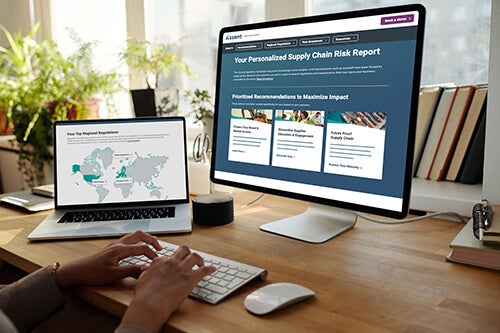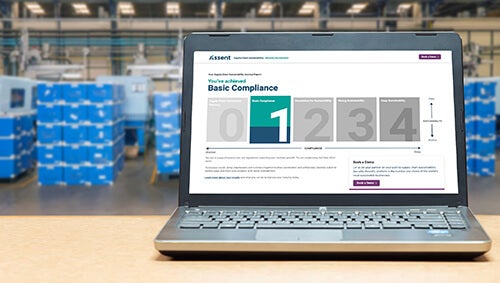Since the U.S. Environmental Protection Agency (EPA) announced tough new restrictions under the Toxic Substances Control Act (TSCA), the new rules prohibiting the use of known persistent, bioaccumulative, and toxic (PBT) substances have companies scrambling for information. With steep penalties for TSCA violations, including major fines and loss of American market access, non-compliance is not an option. We asked renowned EPA experts, Lynn Bergeson and Christopher Blunck, what companies need to know as they ramp up their TSCA compliance programs.
Lynn L. Bergeson is the Managing Partner of Bergeson & Campbell P.C. She is an internationally-recognized expert in TSCA, the EU Registration, Evaluation, Authorisation, and Restriction of Chemicals (REACH) Regulation, and the Federal Insecticide, Fungicide, and Rodenticide Act (FIFRA). She has served as chair of the American Bar Association Section of Environment, Energy, and Resources and is the current President of the Product Stewardship Society.
Christopher R. Blunck is an attorney with Bergeson & Campbell P.C. and recently served as Policy Analyst and Special Assistant to the Directory of the U.S. EPA’s Office of Pollution Prevention and Toxics (OPPT). Over his 30-year career with the EPA, Chris developed and reviewed regulations, policies, and guidance documents. He was awarded the EPA Gold Medal for Exceptional Service for his work implementing the Frank R. Lautenberg Chemical Safety for the 21st Century Act.
- With the EPA promising to revise the PBT rules in 2023, should companies wait to begin scoping their supply chains?Given the existing Section 6 PBT rules are in effect, those in scope should already be comfortable with their compliance status or actively engaged in facilitating a better understanding of it so that corrective action can be taken immediately if issues are discovered. Companies that manufacture, import, process, distribute, or use commercially any of the five PBT chemicals that were regulated under TSCA Section 6 in January 2021 for purposes that are exempted or for which the restrictions or prohibitions are phased in beyond 2023 should prepare for potential further tightening of restrictions. It is unclear what the EPA may propose in 2023.
- Why would the EPA revise the PBT rules? In its September 3, 2021 announcement,the EPA notes that they are reviewing the PBT rules “in light of Executive Orders and other guidance provided by the Biden-Harris Administration.” In that proposed rule, the EPA solicited comments relevant to compliance dates, specifically requesting comment on the PIP (3:1) compliance dates for use in articles and any aspect of the final PBT rules. The EPA states further in the September announcement that “After further review, EPA is considering revising all five of the final rules to further reduce exposures, promote environmental justice, and better protect human health and the environment.”
- What can companies expect when the PIP 3:1 NAA order expires? The PIP (3:1) No Action Assurance (NAA) originally issued on March 8, 2021, was extended an additional 12 months. For such articles, the final rule also extends the compliance date for the recordkeeping requirements applicable to manufacturers, processors, and distributors from March 8, 2021, to March 8, 2022. The EPA states in its September 3, 2021, announcement on the PBT rules that it intends to soon issue a proposed rule that would extend further certain compliance dates, and that it intends to extend certain compliance dates before March 8, 2022.
- Will the next batch of TSCA restrictions be withheld until the 2023 rules are issued? No. The EPA is moving forward with revising risk evaluations for the “first 10” chemicals designated for risk evaluation where appropriate in light of policy changes being taken by the Biden Administration and developing risk management actions where unreasonable risks are found. Additionally, for the “next 20” chemicals currently undergoing risk evaluation, the EPA will move to develop risk management actions to address unreasonable risks. Furthermore, chemicals that are the subjects of manufacturer requests for risk evaluations that are granted by the EPA and for which any unreasonable risk are found will be the subjects of risk management action by the EPA. These activities will proceed independent of the planned 2023 PBT risk management rules, recognizing the EPA’s resource limitations.
- Why should article manufacturers be paying closer attention to TSCA now? Although the EPA has regulated chemicals when they are part of an article in the past, the EPA has been increasingly using TSCA to cover chemicals that are parts of articles, including when articles are imported, processed, and/or distributed. Examples include the TSCA Section 5 Significant New Use Rules (SNUR) issued in July 2020 on certain per- and polyfluoroalkyl substance (PFAS) chemicals. We expect this trend to continue.
- Does the EPA’s insistence that TSCA applies to finished articles have ramifications outside of Section 6 restrictions? Yes. For example, the EPA has lifted the general exemptions for importers and processors of chemicals that are parts of articles in certain Section 5 SNURs and has included reporting and recordkeeping requirements for importers of PFAS-containing articles, among other manufacturers, in a proposed TSCA Section 8(a) rule on PFAS. Of note, the exemptions the EPA included for chemical substances imported as parts of articles under EPA’s 1977 TSCA Section 8 Inventory Reporting Rule (42 Fed. Reg. 64572 (Dec. 23, 1977)), TSCA Section 5 Premanufacture Notification (PMN) Rule (40 C.F.R. Part 720), and TSCA Section 8 Chemical Data Reporting (CDR) Requirements (40 C.F.R. Part 711) would be unnecessary if the EPA’s view was that TSCA does not apply to articles and their components. As evidenced by these regulations, the EPA’s position that TSCA covers articles and their components is not new.
- What lessons should companies have learned from the PBT rule experience? As illustrated by the ongoing regulatory chaos associated with the TSCA Section 6 PBT rule on PIP (3:1) in particular, it is essential that companies better understand the chemicals in their supply chains, including the constituents of formulated products and articles manufactured, imported, processed, and distributed. This enables companies to characterize to the EPA the economic impacts of planned and proposed rules during the EPA’s consideration of such actions, including the time and resources needed to find and qualify alternatives. The EPA cannot develop informed regulations without input from those potentially affected. Additionally, as the EPA holds persons to a strict liability compliance standard under Section 6 rules, a company’s understanding of the chemicals in its supply chain is fundamental to achieving compliance.
- What can a company do if it doesn’t have the ability to detect PBTs in its supply chain? Companies can take steps to help ensure that they are in compliance. For example, importers, processors, and distributors can specify products and articles made without regulated PBTs in their purchase contracts or orders. Companies can also request that their suppliers provide them with a written statement or certification that the purchased or supplied goods are made without a regulated PBT or another prohibited chemical. Importers may also choose to rely on their understanding of the uses of the PBT chemicals and any special knowledge of the imported products and articles and the manufacturing process to assess the probability that a restricted PBT chemical is present. Testing of material is also an option, although an expensive one, especially if many materials or suppliers are involved. In the event that the EPA discovers non-compliance, they determine an appropriate enforcement response based on, among other things, the good faith efforts of the entity involved. This would include the steps taken by the entity, including those described above, to help ensure compliance.
Think you might need a solution for your TSCA requirements? Download Assent’s TSCA Section 6 Handbook for a complete breakdown of your requirements, the PBT rules, and incoming restrictions. Assent’s TSCA solution is the fastest way to scope your supply chain for newly restricted substances and ensure your company’s compliance with new the requirements. Book your personal demo today!







